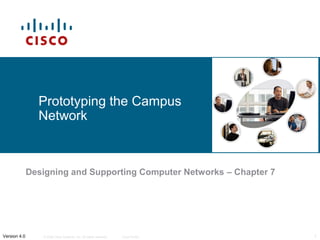More Related Content
Similar to CCNA Discovery 4 - Chapter 7
Similar to CCNA Discovery 4 - Chapter 7 (17)
More from Irsandi Hasan (20)
CCNA Discovery 4 - Chapter 7
- 1. Prototyping the Campus
Network
Designing and Supporting Computer Networks – Chapter 7
Version 4.0 © 2006 Cisco Systems, Inc. All rights reserved. Cisco Public 1
- 2. Objectives
Describe the purpose for and procedures to build a
prototype of the network design
Create test plans to perform simulated or prototype
test of important design elements
Perform proof-of-concept tests on LAN design
elements
Identify risks and weaknesses in the design based on
the proof-of-concept test conclusions
© 2006 Cisco Systems, Inc. All rights reserved. Cisco Public 2
- 3. Describe the Purpose for and Procedures
to Build a Prototype of the Network
Design
Prototype network: a separate network built to replicate
only the portion of a network necessary to test
particular functions or capabilities
Pilot network: using a portion of an existing network to
test a new functionality or capability
© 2006 Cisco Systems, Inc. All rights reserved. Cisco Public 3
- 4. Describe the Purpose for and Procedures
to Build a Prototype of the Network
Design
Create a test plan before beginning the testing process
Create a test plan document containing descriptions of
the design and topology, test procedures, and
anticipated results
© 2006 Cisco Systems, Inc. All rights reserved. Cisco Public 4
- 5. Describe the Purpose for and Procedures
to Build a Prototype of the Network
Design
Methods to verify that a design meets the identified
business criteria:
Prototyping
Basic connectivity tests
Functionality testing
Checklists
© 2006 Cisco Systems, Inc. All rights reserved. Cisco Public 5
- 6. Describe the Purpose for and Procedures
to Build a Prototype of the Network
Design
Tools and methods used to validate that the design is
working as anticipated:
Cisco IOS commands
IP utilities and tools
Protocol analyzers
Network simulation tools
© 2006 Cisco Systems, Inc. All rights reserved. Cisco Public 6
- 7. Describe the Purpose for and Procedures
to Build a Prototype of the Network
Design
Test the redundancy and resiliency of a specific network
design:
Overcoming device and link failures
Redundant links
Load balancing
© 2006 Cisco Systems, Inc. All rights reserved. Cisco Public 7
- 8. Describe the Purpose for and Procedures
to Build a Prototype of the Network
Design
Identify what represents a risk or weakness in the
design
© 2006 Cisco Systems, Inc. All rights reserved. Cisco Public 8
- 9. Prototype the Hierarchical Network, Routing
Protocol, and IP Addressing Model
Identify goals and requirements met by LAN design:
Testing the new design
Determining what needs to be tested
© 2006 Cisco Systems, Inc. All rights reserved. Cisco Public 9
- 10. Prototype the Hierarchical Network, Routing
Protocol, and IP Addressing Model
Create the test plan:
List test outcomes that support business goals
Provide a checklist of success criteria
© 2006 Cisco Systems, Inc. All rights reserved. Cisco Public 10
- 11. Prototype the Hierarchical Network, Routing
Protocol, and IP Addressing Model
Develop methodologies for comparing devices and
topologies
© 2006 Cisco Systems, Inc. All rights reserved. Cisco Public 11
- 12. Prototype the Hierarchical Network, Routing
Protocol, and IP Addressing Model
Develop methodologies for validating the choice of
routing protocol
© 2006 Cisco Systems, Inc. All rights reserved. Cisco Public 12
- 13. Prototype the Hierarchical Network, Routing
Protocol, and IP Addressing Model
Apply and test an appropriate addressing scheme
© 2006 Cisco Systems, Inc. All rights reserved. Cisco Public 13
- 14. Prototype the Hierarchical Network, Routing
Protocol, and IP Addressing Model
Compare and analyze risks or weaknesses associated
with choosing LAN devices, topologies, and addressing:
Lack of redundancy
Single ISP for Internet connectivity
Limited bandwidth areas
Limited fiber connectivity
© 2006 Cisco Systems, Inc. All rights reserved. Cisco Public 14
- 15. Prototype the Server Farm, Including
Security and High Availability
Identify the business goals and technical requirements
supporting server relocation to a data center including a
server farm.
© 2006 Cisco Systems, Inc. All rights reserved. Cisco Public 15
- 16. Prototype the Server Farm, Including
Security and High Availability
Create a success criteria checklist to support business
goals and technical requirements for the server farm
© 2006 Cisco Systems, Inc. All rights reserved. Cisco Public 16
- 17. Prototype the Server Farm, Including
Security and High Availability
Develop methodologies
for comparing devices
and topologies:
Creating a baseline
LAN simulation with
specific protocols
(PVRST+)
© 2006 Cisco Systems, Inc. All rights reserved. Cisco Public 17
- 18. Prototype the Server Farm, Including
Security and High Availability
Prototype the server farm, validating security and
availability:
Availability requirements
Multilayer security
Firewalls
ACL design
© 2006 Cisco Systems, Inc. All rights reserved. Cisco Public 18
- 19. Prototype the Server Farm, Including
Security and High Availability
Build and analyze the prototype of the LAN to ensure
business goals and technical requirements have been
met
© 2006 Cisco Systems, Inc. All rights reserved. Cisco Public 19
- 20. Prototype the Server Farm, Including
Security and High Availability
Compare and analyze the risks or weaknesses
associated with choosing server farm devices,
topologies, and addressing
© 2006 Cisco Systems, Inc. All rights reserved. Cisco Public 20
- 21. Summary
The decision to create a prototype or pilot network
depends on the type of testing required and the
potential disruption to the existing network.
Before beginning any testing, a test plan should be
developed.
Prototypes and simulations can be used to identify risks
and areas of weakness in the network design.
© 2006 Cisco Systems, Inc. All rights reserved. Cisco Public 21
- 22. © 2006 Cisco Systems, Inc. All rights reserved. Cisco Public 22

